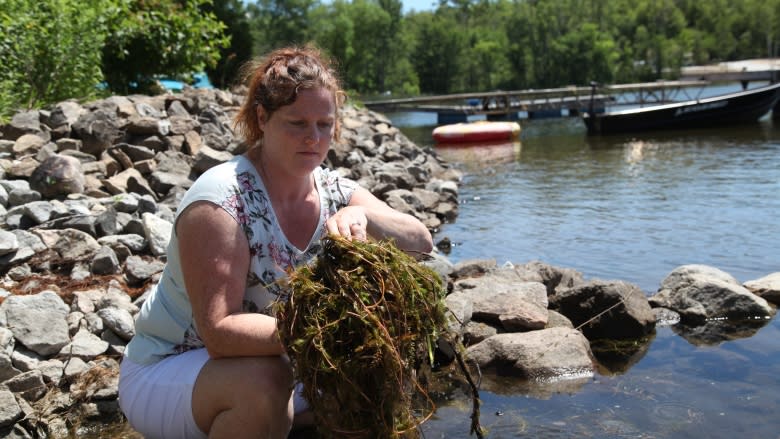'Zombie plant' threatening Ontario's lakes
A troublesome "zombie plant" that comes back to life even after being severed from its root system is invading Ontario's lakes and rivers, conservationists warn — and there's little hope of eradicating it.
The Eurasian watermilfoil was first discovered in Ontario in Lake Erie in 1961, but now threatens pristine cottage country from Muskoka to eastern Ontario.
Barbara King, executive director of Watersheds Canada, a non-profit conservancy based in Perth, Ont., says the plant chokes out native vegetation and can eventually affect water quality, fish and other wildlife.
"If you have a lot of boating motors and people going from lake to lake, it can get caught on the propellers of boats and as it floats and gets into another lake, one tiny fragment will root, and that's how it spreads," King said.
At a public boat launch on Crow Lake, southwest of Perth, King pointed out submerged mats of the red-tinged watermilfoil and offered a grim prognosis.
"It's a constant battle," she said. "You're dealing with management, not eradication."
King warned boaters to carefully clean their crafts, as well as fishing equipment and boat trailers, to help reduce the plant's spread.
Fish killer
King said the species flourishes in depths of one to 10 metres, and spreads easily — especially when it's been cut into small pieces.
As Eurasian watermilfoil decomposes, the plant can kill fish because it reduces oxygen levels in the water.
"Once it's in a lake and established it's virtually impossible to eradicate," King said. "It chokes out all the native vegetation ... and it can have an impact on water quality and fish and wildlife."
Identification a challenge
Ontario's Invading Species Awareness Program identifies five key features that help distinguish the Eurasian watermilfoil from a similar, native plant.
- It's a perennial that grows under the water's surface.
- Feather-like green leaves circle the stem in groups of four or five.
- Leaves have 12 or more thread-like segments.
- Tiny, reddish flowers grow on spikes five to 20 centimetres long that rise above the water.
- The plant blooms in late July and early August.
At her longtime family cottage on Crow Lake, Christine Gemmell admitted she'd noticed the so-called zombie plant in the shallow water of the bay.
"It just grows back. I don't know what you'd do to get rid of that," she said.
The plant, whose scientific name is Myriophyllum spicatum, flowers twice a year, typically in mid-June and late July, but its root system can survive the winter.
Quebec has invested $8 million to combat the plant's spread.
Fisheries and Oceans Canada has also set up hotlines across Canada to report any aquatic invasive species.
Correction : A previous version of this article said Eurasian watermilfoil was first discovered in Ontario in 2007. In fact, it was first spotted in Ontario in 1961.(Jul 20, 2018 11:48 AM)



